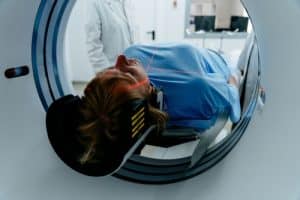Who are the beneficiaries of Liver Fat Quantification?
Those with risk factors such as obesity, Type 2 diabetes, metabolic syndrome, patients with known liver conditions, asymptomatic individuals, weight loss program participants, elevated liver enzymes, and candidates considering bariatric surgery.
Several noninvasive imaging techniques are employed for liver fat quantification, each offering unique insights into liver health. Ultrasound Imaging is a noninvasive and widely accessible method, cost-effective, and provides real-time images for immediate assessments. However, it may lack precision in fat quantification and be operator-dependent.
-
MRI for precise assessment of hepatic fat
MRI (Magnetic Resonance Imaging) offers high precision, especially with proton density fat fraction (PDFF) measurement, but the operator’s skill and experience can influence its results.

-
CT scans and FibroScan for assessing hepatic steatosis
CT scans offer quantitative measurements of liver fat density but have potential health risks and limited soft tissue contrast. Similarly, FibroScan measures fatty liver and stiffness, aiding in diagnosing fibrosis and cirrhosis. However, results may be influenced by the operator’s proficiency and may be less accurate in obese individuals or those with ascites.
How will you know the proper method for you? How will you know the proper method for you? The choice of quantification technique for assessing liver health depends on factors such as precision requirements, cost considerations, accessibility, and the need for additional information. A comprehensive approach may involve combining different methods for a more thorough assessment.
After liver fat quantification, the results are interpreted to assess the organ’s health. Average results suggest a healthy liver, while elevated lipid levels prompt further evaluation. Individuals can discuss results and risk factors with their healthcare provider, leading to lifestyle changes or medical interventions. If necessary, additional tests may be recommended to identify underlying causes.
Collaborative Care
Specialists like gastroenterologists or hepatologists may be referred in severe cases or when underlying conditions are present. Patients receive educational counselling on maintaining a healthy lifestyle, managing risk factors, and adhering to prescribed treatments.
In conclusion, liver fat quantification is a valuable diagnostic tool that can help identify individuals at risk of liver-related complications, tailor personalized treatment plans, monitor disease progression, and evaluate intervention effectiveness.
Book your Liver Fat Quantification today






